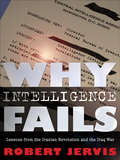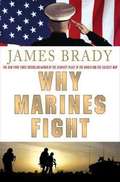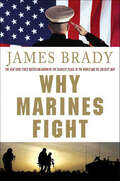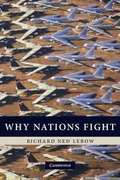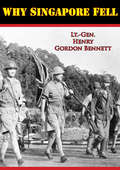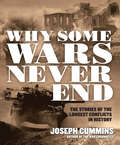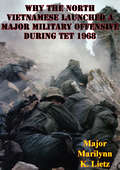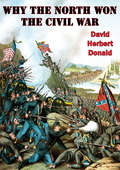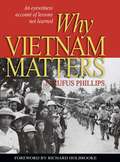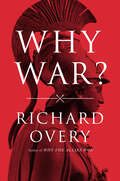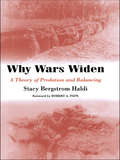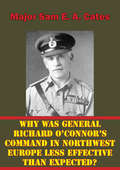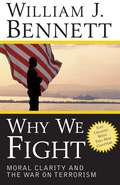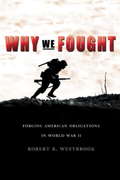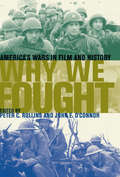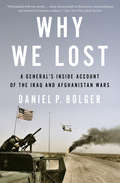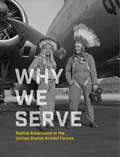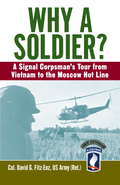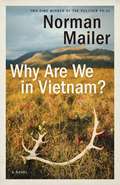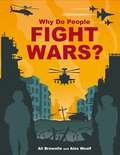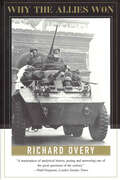- Table View
- List View
Why Intelligence Fails: Lessons from the Iranian Revolution and the Iraq War
by Robert JervisDespite the resources at their command, U. S. intelligence services failed to anticipate the fall of the Shah's government in Iran in the late 1970s and, more recently, insisted that Saddam Hussein's regime possessed weapons of mass destruction. In this book, Jervis (International Politics, Columbia University) examines both failures, and rejects the common explanations that attribute these failures to political pressure and groupthink. Instead, the author suggests that the failures were a result of an organizational culture that failed to look into the factors behind intelligence assessments or to investigate alternative explanations. Although Jervis' writing can be on the dry side (especially in the part of the book about Iran), this his book is an essential read for anyone wanting to understand the workings of U. S. intelligence agencies, or the history of U. S. involvement in Iraq and Iran. Annotation ©2010 Book News, Inc. , Portland, OR (booknews. com)
Why Is Veteran Unemployment So High?
by David S. LoughranAccording to official statistics, the unemployment rate of young military veterans ages 18-24 reached 29 percent in 2011. This report seeks to put that statistic in perspective by examining the historical time-series of veteran unemployment, comparing the veteran unemployment rate to that of non-veterans, and examining how veteran unemployment varies with time since military separation. Between 2000 and 2011, younger veterans were, on average, 3.4 percentage points more likely to be unemployed than similarly situated younger non-veterans. However, this difference between veteran and non-veteran unemployment falls rapidly with age and time since military separation. The report concludes that the best available evidence supports the hypothesis that relatively high rates of veteran unemployment reflect the fact that veterans, especially younger veterans, are more likely to have recently separated from a job — namely, military service — and, consequently, are more likely to be engaged in job search, which takes time, especially during periods of slow economic growth. The available evidence lends little support to the hypothesis that veterans are inherently disadvantaged in the civilian labor market. Limiting unemployment benefits available to recently separated veterans would likely reduce the length of unemployment spells, but the net effect of such a policy action on the long-term federal budget is unclear. There is very limited evidence on the effectiveness of other federal policies aimed at facilitating the transition of veterans into the civilian labor market.
Why Marines Fight
by James BradyUnited States Marines, for more than two centuries, have been among the world's fiercest and most admired of warriors. They have fought from the Revolutionary War to Afghanistan and Iraq, in famous battles become bone and sinew of American lore. But why do Marines fight? Why fight so well? Why run toward the guns? Now comes a thrilling new book, pounding and magnificent in scope, by the author some Marines consider the unofficial 'poet laureate' of their Corps. James Brady interviews combat Marines from wars ranging from World War II to Afghanistan, their replies in their own individual voices unique and powerful, an authentically American story of a country at war, as seen through the eyes of its warriors. Culling his own correspondence and comradeship with hundreds of fellow Marines, Brady compiles a story--lyrical and historical--of the motivations and emotions behind this compelling question. Included are the accounts of Senator James Webb and his lance corporal son, Jim; New York City police commissioner Ray Kelly; Yankee second baseman (and Marine fighter pilot) Jerry Coleman, and of teachers, firemen, authors, cops, Harvard football players, and just plain grunts, as well as the unforgettable story of Jack Rowe, who lost an eye and other parts and now grows avocados and chases rattlesnakes. Their stories poignantly and profoundly illustrate the lives and legacies of battlefront Marines. Why Marines Fight is a ruthlessly candid book about professional killers not ashamed to recall their doubts as well as exult in their savagely triumphant battle cries. A book of weight and heft that Marines, and Americans everywhere, will want to read, and may find impossible to forget.
Why Marines Fight
by James BradyJames Brady, bestselling war memoirist, and Marine officer in Korea, returns with one of his most memorable works to date--exploring what it means to be a soldier and why Marines fight. United States Marines, for more than two centuries, have been among the world's fiercest and most admired of warriors. They have fought from the Revolutionary War to Afghanistan and Iraq, in famous battles become bone and sinew of American lore. But why do Marines fight? Why fight so well? Why run toward the guns? Now comes a thrilling new book, pounding and magnificent in scope, by the author some Marines consider the unofficial "poet laureate" of their Corps.James Brady interviews combat Marines from wars ranging from World War II to Afghanistan, their replies in their own individual voices unique and powerful, an authentically American story of a country at war, as seen through the eyes of its warriors. Culling his own correspondence and comradeship with hundreds of fellow Marines, Brady compiles a story--lyrical and historical--of the motivations and emotions behind this compelling question. Included are the accounts of Senator James Webb and his lance corporal son, Jim; New York City police commissioner Ray Kelly; Yankee second baseman (and Marine fighter pilot) Jerry Coleman, and of teachers, firemen, authors, cops, Harvard football players, and just plain grunts, as well as the unforgettable story of Jack Rowe, who lost an eye and other parts and now grows avocados and chases rattlesnakes. Their stories poignantly and profoundly illustrate the lives and legacies of battlefront Marines.Why Marines Fight is a ruthlessly candid book about professional killers not ashamed to recall their doubts as well as exult in their savagely triumphant battle cries. A book of weight and heft that Marines, and Americans everywhere, will want to read, and may find impossible to forget.
Why Nation-Building Matters: Political Consolidation, Building Security Forces, and Economic Development in Failed and Fragile States
by Keith W. MinesNo one likes nation-building. The public dismisses it. Politicians criticize it. The traditional military disdains it, and civilian agencies lack the blueprint necessary to make it work. Yet functioning states play a foundational role in international security and stability. Left unattended, ungoverned spaces can produce crises from migration to economic collapse to terrorism. Keith W. Mines has taken part in nation-building efforts as a Special Forces officer, diplomat, occupation administrator, and United Nations official. In Why Nation-Building Matters he uses cases from his own career to argue that repairing failed states is a high-yield investment in our own nation&’s global future. Eyewitness accounts of eight projects––in Colombia, Grenada, El Salvador, Somalia, Haiti, Darfur, Afghanistan, and Iraq—inform Mines&’s in-depth analysis of how foreign interventions succeed and fail. Building on that analysis, he establishes a framework for nation-building in the core areas of building security forces, economic development, and political consolidation that blend soft and hard power into an effective package. Grounded in real-world experience, Why Nation-Building Matters is an informed and essential guide to meeting one of the foremost challenges of our foreign policy present and future.
Why Nations Fight
by Richard Ned LebowFour generic motives have historically led states to initiate war: fear, interest, standing and revenge. Using an original dataset, Richard Ned Lebow examines the distribution of wars across three and a half centuries and argues that, contrary to conventional wisdom, only a minority of these were motivated by security or material interest. Instead, the majority are the result of a quest for standing, and for revenge - an attempt to get even with states who had previously made successful territorial grabs. Lebow maintains that today none of these motives are effectively served by war - it is increasingly counterproductive - and that there is growing recognition of this political reality. His analysis allows for more fine-grained and persuasive forecasts about the future of war as well as highlighting areas of uncertainty.
Why Rivals Intervene: International Security and Civil Conflict
by John MittonRivals – states with acrimonious, militarized histories – often intervene on opposing sides of civil conflicts. These interventions are known to exacerbate and prolong civil wars, but scholars have yet to fully understand why states engage in them, given the significant costs and countervailing strategic interests. Why Rivals Intervene argues that rivals are driven by security considerations at the international level – specifically, the prospect of future confrontations with their rival – to intervene in civil conflicts. Drawing on a theory of rivalry which accounts for this strategic rationale, John Mitton explores three case studies: Indian and Pakistani intervention in Afghanistan, Israeli and Syrian intervention in Lebanon, and US and Soviet intervention in Angola. The book examines a range of evidence, including declassified memoranda, meeting transcripts, government reports, published interviews, memoirs of political leaders, and other evidence of the thought process, rationale, and justifications of relevant decision-makers. The book claims that the imperatives for intervention are consistent across time and space, as rivals are conditioned by a history of conflict to worry about future confrontations. As a result, Why Rivals Intervene illuminates an important driver of civil conflict, with implications for how such conflicts might be solved or mitigated in the future. At the same time, it offers new insight into the nature of long-standing, acrimonious international relationships.
Why Singapore Fell
by Lt.-Gen. Henry Gordon BennettIncludes more than 30 maps, plans and illustrationsThe fall of Singapore, the "Gibraltar of the East", struck by the Imperial Japanese troops during the lightning Malaya campaign of 1942 was a great shock to the Allied cause during the Second World War. No less a person than Prime Minister Winston Churchill assessed it as the "worst disaster" and the "largest capitulation" in British military history. 85,000 British, Indian and Australian troops were marched into the captivity with 50,000 others who had been captured already in the campaign, their fate was to be a barbaric fate in the hands of the Japanese. Their commanders were to be made scapegoats and pilloried for not stopping the disaster, but the true blame in large part lies elsewhere...Australian General Henry Gordon Bennett's account of the disaster is a gripping defence of his part in the campaign. Sent troops who were ill-equipped, with no experience, and little proper training; the Singapore command attempted to defend their position. Impregnable from seaborne assault, the walls, bastions and fixed positions were no help against the inland advance of the Japanese and with few antiquated fighters to protect them against the heavy air bombardment the Gordon Bennett and his men struggled against the odds. Starved of reinforcements, withheld in Australia and Great Britain, the men and their commanders had to do the best with what they had. In this fascinating book it would seem like the island fortress was doomed from the start in spite of the misguided high hopes of the high command.
Why Some Wars Never End: The Stories of the Longest Conflicts in History
by Joseph CumminsFourteen of history’s longest-running military conflicts, from the Greco-Persian Wars to the Sudanese Civil War.Sometimes the causes of war are so intractable, the opponents so unyielding, and the rivalries so deep-rooted that the combat continues for years, decades, even centuries. And often when it does abate, the resentments still smolder, so that the slightest spark might reignite the conflagration.An at once captivating and unsettling volume, Why Some Wars Never End shines a spotlight on fourteen of history’s longest-running conflicts. They range from the almost century-long Punic Wars, which saw ancient Rome achieve dominance over the Mediterranean and lay the foundations of its world-changing empire, to the seventy years of uprisings and bloody encounters that triggered the Jewish Diaspora in the second century CE, to the nineteenth-century Seminole Wars, which virtually wiped out the Seminole Indians, to the violent British suppression of Afghan self-rule that set the stage for that nation’s distressing contemporary plight.Each of these wars had consequences and influences far beyond its source and the reach of its battles, not only redrawing political boundaries, but also coloring the worldview of generations of participants and bystanders, and thereby refashioning entire cultures. And all demonstrate, in harrowing fashion, why violence still stains our modern world, and why warfare shows no sign of ending any time soon.Praise for Joseph Cummins“This book is worthy of a place in the libraries of historians and politicians alike. Its stories of the past warn us about the future. Recommended.” —Armchair General on The World’s Bloodiest History“Gripping stories and lively writing.” —Library Journal on History’s Greatest Untold Stories
Why The North Vietnamese Launched A Major Military Offensive During Tet 1968
by Major Marilynn K. LietzThis study examines the reasons why the North Vietnamese launched a general offensive during the Tet holiday of 1968. Based on events of the previous year, conditions did not appear favorable for the North Vietnamese to undertake such a massive and risky operation. Several reasons accounted for this decision; political pressure from Russia and China for a resolution to the war, military failure to achieve victory through the use of the dau tranh strategy of war, the increasing inability of the Vietnamese people-North and South-to provide economic and social support for the war, and impatience on the part of the North Vietnamese leaders. North Vietnam's goal was to hasten the resolution of the war by a massive offensive and to quickly bring the United States and South Vietnam to the negotiating table. By prematurely launching this offensive, the North Vietnamese did not comply with the dau tranh model strategy of revolutionary war.
Why The North Won The Civil War (Paperbook Series In History)
by David Herbert DonaldWHY THE SOUTH LOSTWhat led to the downfall of the Confederacy? The distinguished professors of history represented in this volume examine the following crucial factors in the South's defeat:ECONOMIC--RICHARD N. CURRENT of the University of Wisconsin attributes the victory of the North to fundamental economic superiority so great that the civilian resources of the South were dissipated under the conditions of war.MILITARY--T. HARRY WILLIAMS of Louisiana State University cites the deficiencies of Confederate strategy and military leadership, evaluating the influence on both sides of Baron Jomini, a 19th-century strategist who stressed position warfare and a rapid tactical offensive.DIPLOMATIC--NORMAN A. GRAERNER of the University of Illinois holds that the basic reason England and France decided not to intervene on the side of the South was simply that to have done so would have violated the general principle of non-intervention to which they were committed.SOCIAL--DAVID DONALD of Columbia University offers the intriguing thesis that an excess of Southern democracy killed the Confederacy. From the ordinary man in the ranks to Jefferson Davis himself, too much emphasis was placed on individual freedom and not enough on military discipline.POLITICAL--DAVID M. POTTER of Stanford University suggests that the deficiencies of President Davis as a civil and military leader turner the balance, and that the South suffered from the lack of a second well-organized political party to force its leadership into competence.
Why They Die: Civilian Devastation in Violent Conflict
by Rothbart Daniel Korostelina Karina V."A welcome contribution to our understanding of the process at work in societies in conflict---a process that can occur even before the fighting begins---this book convincingly argues the need to bring civilians, who are often not at the center of conflict analysis, to the forefront of any discussion of conflict through an examination of anti-civilian ideology and the construction of the Other in terms of the positioning of boundaries. " ---Kristen P. Williams, Clark University "The authors convincingly dismiss conventional accounts---collateral damage is unavoidable, war is hell, etc. ---and insist that the insights of identity studies can provide a more complete perspective on this issue. " ---John Parry, Lewis & Clark Law School "Why They Dieis a work of imagination and insight. Based on wide reading and deep reflection, the authors have adopted a case study method to illustrate why it is that civilians are so often targeted in modern conflict, and why this development is such a departure from earlier forms of warfare. Rather than being that unfortunate phenomenon 'collateral damage,' as so often claimed by military theorists, the modern world has seen a situation where the destruction of civilian lives has all too often become the object of combatant behaviors. Rothbart and Korostelina have shown why this has happened, and how such behaviors can be explained. All in all, this is an excellent and worthy addition to a growing literature of mass murder, mayhem, and destruction. " ---Paul R. Bartrop, Bialik College, Melbourne, Australia Why do civilians suffer most during times of violent conflict? Why are civilian fatalities as much as eight times higher, calculated globally for current conflicts, than military fatalities? InWhy They Die, Daniel Rothbart and Karina V. Korostelina address these questions through a systematic study of civilian devastation in violent conflicts. Pushing aside the simplistic definition of war as a guns-and-blood battle between two militant groups, the authors investigate the identity politics underlying conflicts of many types. During a conflict, all those on the opposite side are perceived as the enemy, with little distinction between soldiers and civilians. As a result, random atrocities and systematic violence against civilian populations become acceptable. Rothbart and Korostelina devote the first half of the book to case studies: deportation of the Crimean Tatars from the Ukraine, genocide in Rwanda, the Lebanon War, and the war in Iraq. With the second half, they present new methodological tools for understanding different types of violent conflict and discuss the implications of these tools for conflict resolution. Jacket photograph: © iStockphoto. com/Tina Rencelj
Why Vietnam Matters
by Rufus C. Phillips IIIIn The Best and the Brightest, David Halberstam described Rufus Phillips as a man one could trust telling President Kennedy during the Vietnam War about the failures of the Strategic Hamlet Program, 'in itself a remarkable moment in the American bureaucracy, a moment of intellectual honesty.' With that same honesty, Phillips gives an extraordinary inside history of the most critical years of American involvement in Vietnam, from 1954 to 1968, and explains why it still matters. Describing what went right and then wrong, he argues that the United States missed an opportunity to help the South Vietnamese develop a political cause as compelling as that of the Communists by following a big war strategy based on World War II perceptions. This led American policy makers to mistaken assumptions that they could win the war themselves and give the country back to the Vietnamese. Documenting the story from his own private files as well as from the historical record, the former CIA officer paints striking portraits of such key figures as John F. Kennedy, Maxwell Taylor, Robert McNamara, Henry Cabot Lodge, Hubert Humphrey, and Ngo Dinh Diem, among others with whom he dealt.Phillips details how the legendary Edward G. Lansdale helped the South Vietnamese gain and consolidate their independence between 1954 and 1956, and how this later changed to a reliance on American conventional warfare with its highly destructive firepower. He reasons that our failure to understand the Communists, our South Vietnamese allies, or even ourselves took us down the wrong road. In summing up U.S. errors in Vietnam, Phillips draws parallels with the American experience in Iraq and Afghanistan and suggests changes in the U.S. approach. Known for his intellectual integrity and firsthand, long-term knowledge of what went on in Vietnam, the author offers lessons for today in this trenchant account.
Why War?
by Richard OveryWhy has war been such a consistent presence throughout the human past? A leading historian explains, drawing on rich examples and keen insight. Richard Overy is not the first scholar to take up the title question. In 1931, at the request of the League of Nations, Albert Einstein asked Sigmund Freud to collaborate on a short work examining whether there was “a way of delivering mankind from the menace of war.” Published the next year as a pamphlet entitled Why War?, it conveyed Freud’s conclusion that the “death drive” made any deliverance impossible—the psychological impulse to destruction was universal in the animal kingdom. The global wars of the later 1930s and 1940s seemed ample evidence of the dismal conclusion. A preeminent historian of those wars, Overy brings vast knowledge to the title question and years of experience unraveling the knotted motivations of war. His approach is to separate the major drivers and motivations, and consider the ways each has contributed to organized conflict. They range from the impulses embedded in human biology and psychology, to the incentives to conflict developed through cultural evolution, to competition for resources—conflicts stirred by the passions of belief, the effects of ecological stresses, the drive for power in leaders and nations, and the search for security. The discussions show remarkable range, delving deep into the Neolithic past, through the twentieth-century world wars, and up to the current conflict in Ukraine. The examples are absorbing, from the Roman Empire’s voracious appetite for resources to the impulse to power evident in Alexander the Great, Napoleon, and Hitler. The conclusion is not hopeful, but Overy’s book is a gift to readers: a compact, judicious, engrossing examination of a fundamental question.
Why Wars Widen: A Theory of Predation and Balancing
by Stacy Bergstrom HaldiThis work explains how wars are most likely to escalate when the effects of warfare are limited. The author demonstrates that total wars during the modern era were very violent and were far less likely to spread, yet the cost of warfare is falling making future conflicts more likely to spread.
Why Was General Richard O’Connor’s Command in Northwest Europe Less Effective Than Expected?
by Major Sam E. A. CatesGeneral Richard O'Connor was the British VIII Corps commander in Normandy 1944. Previously he forged an outstanding reputation as a large unit commander in the desert of North Africa and this form suggests his command in Northwest Europe would be faultless. However, this was not the case. Some historians explain his pedestrian performance in Normandy by pointing to his two and a half years as a prisoner of war in Italy. This monograph challenges this narrative suggesting instead that O'Connor's command style was not suited to the context of war in Normandy. General O'Connor had a wealth of relevant military experience. The crucible of World War and his experiences commanding the Western Desert Force in North Africa created in him a style of command that was best suited to independent operations, on ground that facilitated effective maneuver, and with conditions that enable the achievement of the element of surprise. Yet in Normandy 1944, the context in which General O'Connor commanded did not allow for any of these conditions. Rather, a constrictive chain of command, narrow fronts, restrictive terrain, and the difficulty of achieving surprise all combined to provide a context in which General O'Connor was a less effective corps commander than expected.
Why We Fight: Moral Clarity and the War on Terrorism
by William J. BennettThe events of September 11, 2001, were an unforgettable tragedy, but they also revealed that the spirit of America is strong and undiminished. Not since the shocking attack on Pearl Harbor has the nation pulled together with such unity and purpose, resolving to endure whatever hardships may be necessary to win the war on terror. We were united in the defense of and belief in our country. It truly brought out the best in our national character. In clear, compelling, straightforward language, William Bennett takes up and refutes the many myths and misconceptions about America’s character and role in world affairs that have become fashionable among our nation’s elites. The morning of September 12 dawned with a stunning moral clarity that has guided the actions of many Americans, both her leaders and her citizens. Bennett seeks to preserve that clarity in order to ensure that our national resolve does not falter in this difficult and necessary war.
Why We Fought
by Robert B. WestbrookWhy We Fought is a timely and provocative analysis that examines why Americans really chose to sacrifice and commit themselves to World War II. Unlike other depictions of the patriotic "greatest generation," Westbrook argues that, strictly speaking, Americans in World War II were not instructed to fight, work, or die for their country--above all, they were moved by private obligations. Finding political theory in places such as pin-ups of Betty Grable, he contends that more often than not Americans were urged to wage war as fathers, mothers, husbands, wives, lovers, sons, daughters, and consumers, not as citizens. The thinness of their own citizenship contrasted sharply with the thicker political culture of the Japanese, which was regarded with condescending contempt and even occasionally wistful respect.Why We Fought is a profound and skillful assessment of America's complex political beliefs and the peculiarities of its patriotism. While examining the history of American beliefs about war and citizenship, Westbrook casts a larger light on what it means to be an American, to be patriotic, and to willingly go to war.From the Trade Paperback edition.
Why We Fought: America's Wars in Film and History (Film and History #Fmhi)
by Peter C. Rollins John E. O'ConnorA &“wide-ranging and sophisticated anthology&” comparing theaters of war to wars in the movie theater (Dennis Showalter, author of Patton and Rommel). Why We Fought makes a powerful case that film can be as valuable a tool as primary documents for improving our understanding of the causes and consequences of war. A comprehensive look at war films, from depictions of the American Revolution to portrayals of September 11 and its aftermath, this volume contrasts recognized history and historical fiction with the versions appearing on the big screen. The text considers a selection of the pivotal war films of all time, including All Quiet on the Western Front, Sands of Iwo Jima, Apocalypse Now, Platoon, and Saving Private Ryan—revealing how film depictions of the country&’s wars have shaped our values, politics, and culture, and offering a unique lens through which to view American history. Named as a Choice Outstanding Academic Title
Why We Lost: A General's Inside Account of the Iraq and Afghanistan Wars
by Daniel BolgerA high-ranking general's gripping insider account of the U.S. wars in Iraq and Afghanistan, and how it all went wrong.Over a thirty-five-year career, Daniel Bolger rose through the army infantry to become a three-star general, commanding in both theaters of the U.S. campaigns in Iraq and Afghanistan. He participated in meetings with top-level military and civilian players, where strategy was made and managed. At the same time, he regularly carried a rifle alongside rank-and-file soldiers in combat actions, unusual for a general. Now, as a witness to all levels of military command, Bolger offers a unique assessment of these wars, from 9/11 to the final withdrawal from the region. Writing with hard-won experience and unflinching honesty, Bolger makes the firm case that in Iraq and in Afghanistan, we lost -- but we didn't have to. Intelligence was garbled. Key decision makers were blinded by spreadsheets or theories. And, at the root of our failure, we never really understood our enemy. Why We Lost is a timely, forceful, and compulsively readable account of these wars from a fresh and authoritative perspective.
Why We Serve: Native Americans in the United States Armed Forces
by NMAIRare stories from more than 250 years of Native Americans' service in the militaryWhy We Serve commemorates the 2020 opening of the National Native American Veterans Memorial at the Smithsonian National Museum of the American Indian, the first landmark in Washington, DC, to recognize the bravery and sacrifice of Native veterans. American Indians' history of military service dates to colonial times, and today, they serve at one of the highest rates of any ethnic group. Why We Serve explores the range of reasons why, from love of their home to an expression of their warrior traditions. The book brings fascinating history to life with historical photographs, sketches, paintings, and maps. Incredible contributions from important voices in the field offer a complex examination of the history of Native American service. Why We Serve celebrates the unsung legacy of Native military service and what it means to their community and country.
Why a Soldier? A Signal Corpsman's Tour from Vietnam to the Moscow Hot Line
by David Fitz-EnzHe was one of the best, Airborne, proud to serve his country and fight its toughest war--in the hell that was Vietnam. Known to all as "Fitz," Signal Corps officer David Fitz-Enz served two tours in Vietnam. He was a soldier, combat photographer, and platoon leader, fighting America's cruelest war--from the VC-infested rice paddies of the Mekong Delta to the dreaded Ia Drang Valley, where the enemy ruled the night. Dispensing with traditional, sluggish chains of command, the Signal Corps developed a rapid-response system based on greater flexibility, cutting-edge communications technology, and interdependence between the branches of the military during the war. Now commanders in the field were able to call in artillery, air strikes, and reinforcements at a moment's notice. Fitz-Enz himself orchestrated the first-ever hook up over tactical systems between the President in the Oval Office and a general in the Vietnam jungle. The only book of its kind, WHY A SOLDIER? gives us the inside view of the Corps as it launched an exciting new era in strategic and tactical communications that set the groundwork for all future military operations.
Why are We in Vietnam?: A Novel
by Norman Mailer“It is impossible to walk away from this novel without being sharply reminded of the fact that Norman Mailer is a writer of extraordinary ability.”—Chicago TribuneFeaturing a new foreword by Mailer scholar Maggie McKinleyPublished nearly twenty years after Norman Mailer’s fiction debut, The Naked and the Dead, this acclaimed novel further solidified the author’s stature as one of the most important figures in contemporary American literature. Ranald “D. J.” Jethroe, Texas’s most precocious teenager, recounts a brutal hunting trip he took to Alaska—in a story of fathers and sons, myth and masculinity, character and corruption. Both entertaining and profound, Why Are We in Vietnam? is an exceptional, timeless work awaiting discovery by a new generation of readers.Praise for Why Are We in Vietnam? “A book of great integrity. All the old qualities are here: Mailer’s remarkable feeling for the sensory event, the detail, ‘the way it was,’ his power and energy.”—The New York Review of Books “A tour de force, a treatise on human nature.”—The Dallas Morning News “A brilliant piece of writing.”—Newsweek “Original, courageous, and provocative.”—The New York Times
Why do People Fight Wars?
by Alison Brownlie BojangWritten in clear, straightforward language, this book looks at why people go to war and whether it is ever right to kill another person. It explains different attitudes to warfare and why wars are such a major part of history. It also looks at peace keeping organisations and conflict resolution.Questions and topics covered include: What is war?; A brief history of war; Why do wars start?; Why do people fight?; Why do children fight?; Wars and new technology; Colonialism; Exploiting fear; War crimes; Civilians and war; Refugees; After the war; Can war ever be justified?; Are wars reported accurately?; Preventing war and negotiating peace; Resolving conflicts.
Why the Allies Won
by Richard Overy"Overy has written a masterpiece of analytical history, posing and answering one of the great questions of the century."—Sunday Times (London) Richard Overy's bold book begins by throwing out the stock answers to this great question: Germany doomed itself to defeat by fighting a two-front war; the Allies won by "sheer weight of material strength." In fact, by 1942 Germany controlled almost the entire resources of continental Europe and was poised to move into the Middle East. The Soviet Union had lost the heart of its industry, and the United States was not yet armed. The Allied victory in 1945 was not inevitable. Overy shows us exactly how the Allies regained military superiority and why they were able to do it. He recounts the decisive campaigns: the war at sea, the crucial battles on the eastern front, the air war, and the vast amphibious assault on Europe. He then explores the deeper factors affecting military success and failure: industrial strength, fighting ability, the quality of leadership, and the moral dimensions of the war.
